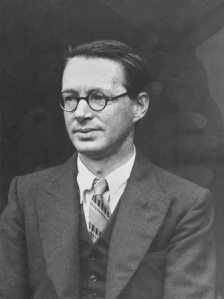 The Annunciation has been a favorite theme with painters, but it has also inspired a fair amount of poetry. Many poems about the Annunciation are really poems about paintings of the Annunciation. This one, by Edwin Muir, is not obviously about any particular painting, but it suggests that the encounter between Mary and the angel was as still as any representation of it could be. Outside the window, the movement of an ordinary day continues: footsteps fall and "with the sun along the wall / Pursue their unreturning way." Inside, bliss has interrupted time: "Immediacy / Of strangest strangeness is the bliss / That from their limbs all movement takes." One is reminded of W. H. Auden's poem "Musée des Beaux Arts," with its observation that suffering "takes place / While someone else is eating or opening a window or just walking dully along." Muir's poem suggests that suffering is not unique in this respect: every kind of intense experience, including bliss, takes place amid the heedless routines of daily life.
The Annunciation has been a favorite theme with painters, but it has also inspired a fair amount of poetry. Many poems about the Annunciation are really poems about paintings of the Annunciation. This one, by Edwin Muir, is not obviously about any particular painting, but it suggests that the encounter between Mary and the angel was as still as any representation of it could be. Outside the window, the movement of an ordinary day continues: footsteps fall and "with the sun along the wall / Pursue their unreturning way." Inside, bliss has interrupted time: "Immediacy / Of strangest strangeness is the bliss / That from their limbs all movement takes." One is reminded of W. H. Auden's poem "Musée des Beaux Arts," with its observation that suffering "takes place / While someone else is eating or opening a window or just walking dully along." Muir's poem suggests that suffering is not unique in this respect: every kind of intense experience, including bliss, takes place amid the heedless routines of daily life.
THE ANNUNCIATION
The angel and the girl are met.
Earth was the only meeting place.
For the embodied never yet
Travelled beyond the shore of space.
The eternal spirits in freedom go.
See, they have come together, see,
While the destroying minutes flow,
Each reflects the other’s face
Till heaven in hers and earth in his
Shine steady there. He’s come to her
From far beyond the farthest star,
Feathered through time. Immediacy
Of strangest strangeness is the bliss
That from their limbs all movement takes.
Yet the increasing rapture brings
So great a wonder that it makes
Each feather tremble on his wings.
Outside the window footsteps fall
Into the ordinary day
And with the sun along the wall
Pursue their unreturning way.
Sound’s perpetual roundabout
Rolls its numbered octaves out
And hoarsely grinds its battered tune.
But through the endless afternoon
These neither speak nor movement make,
But stare into their deepening trance
As if their gaze would never break.
